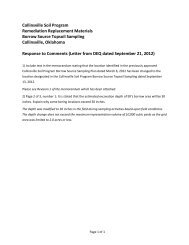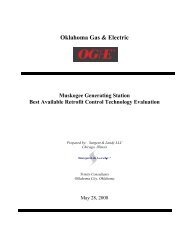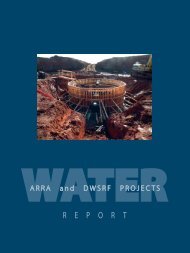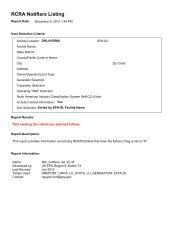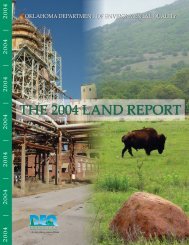Technical documentation and software quality assurance for project ...
Technical documentation and software quality assurance for project ...
Technical documentation and software quality assurance for project ...
Create successful ePaper yourself
Turn your PDF publications into a flip-book with our unique Google optimized e-Paper software.
• radiation levels of concern (LOC)<br />
MODEL DESCRIPTION<br />
Figure 2 shows the flow diagram <strong>for</strong> the module. The model assumes complete tank<br />
failure while the tank is surrounded by fire. This is a common situation <strong>for</strong> a BLEVE<br />
occurrence. A limit of 5000 metric tones is employed as the maximum amount of<br />
chemical that will be modeled. This limit is of the order of the largest historical single<br />
BLEVE incident.<br />
The model calculates only the thermal radiation hazard. The overpressure wave<br />
<strong>and</strong> any fragment hazard are not calculated although warning messages are provided. The<br />
reasons why they are not calculated are several. First, estimates of release energy by<br />
st<strong>and</strong>ard methods can only be given to an order of magnitude. Second, the main hazard<br />
posed by BLEVE of a flammable liquid is the radiation from the resulting fireball<br />
(AICHE Guidelines, 1994). Third, estimates of shrapnel mass, velocity, <strong>and</strong> number are<br />
apt to contain high uncertainties <strong>and</strong> are currently not estimated in the existing ALOHA<br />
code. Although non-flammable pressurized liquid containers can BLEVE, the model will<br />
not calculate effects from these scenarios, since overpressure <strong>and</strong> fragmentation effects<br />
are not calculated<br />
Depending upon the chemical <strong>and</strong> the tank pressure <strong>and</strong> temperature at failure,<br />
not all of the product will flash <strong>and</strong> participate in the fireball. The fraction, f , that<br />
flashes is given by<br />
f = Cp T − T ( b)<br />
Hv where T is the chemical temperature at tank failure, Tb is the ambient boiling point, Cp is the specific heat capacity at constant pressure, <strong>and</strong> H<br />
€<br />
v is the latent heat of<br />
vaporization. If the fraction is more than one third, then the entire tank contents<br />
€ participate in the fireball. If it is less than one<br />
€<br />
third, then following Hasegawa <strong>and</strong> Sato<br />
(1977), three times the amount flashed is used in the fireball calculation. The<br />
€<br />
amount not<br />
contributing to the fireball is used <strong>for</strong> a pool<br />
€<br />
fire scenario.<br />
6<br />
€



